Services on Demand
Journal
Article
Indicators
-
 Cited by SciELO
Cited by SciELO -
 Access statistics
Access statistics
Related links
-
 Cited by Google
Cited by Google -
 Similars in
SciELO
Similars in
SciELO -
 Similars in Google
Similars in Google
Share
CT&F - Ciencia, Tecnología y Futuro
Print version ISSN 0122-5383On-line version ISSN 2382-4581
C.T.F Cienc. Tecnol. Futuro vol.3 no.2 Bucaramanga Jan./Dec. 2006
1 Ecopetrol S.A. – Instituto Colombiano del Petróleo, A.A. 4185 Bucaramanga, Santander, Colombia. e-mail: Carlos.Baldrich@ecopetrol.com.co
2 T.I.P. Ltda., Piedecuesta, Santander, Colombia. e-mail: alexis.bueno@ecopetrol.com.co
(Received May 26, 2006; Accepted Nov. 23, 2006)
ABSTRACT
This paper features the development of a new methodology for the quantification of aromatic species in light and medium fractions derived from petroleum by means of High Performance Liquid Chromatography Associated to a Diode Array Detector (HPLC-UV-DAD). The proposed method is based on the selectivity that the chromatographic system presents when used to separate and detect the aromatic compounds with different number of rings that allow the quantification of defined species such as mono, di and tri-aromatics respectively. A mathematical algorithm was generated to obtain from the ultraviolet spectra of each one of the identified hydrocarbons families the concentration for each specie equivalent to the one generated by high resolution mass spectrometry hydrocarbon type analysis. The method applicability was verified in light samples (diesel) with average relative errors of 1,18%, 3,30% and 15,21% in hydrocarbon determination of mono, di and tri-aromatics respectively. The methodology was preliminary evaluated with light and medium gas oils but unavailability of mass spectrometry data did not allow to test predictive accuracy. This instrumental technique is presented as an alternative for the characterization of light and medium petroleum fractions by HPLC-UV-DAD when traditional methods of analysis are not available.
KeyWords: liquid chromatography, aromatic, hydrocarbon, characterization.
RESUMEN
En este trabajo se presenta el desarrollo de una metodología para la cuantificación de especies aromáticas en fracciones livianas y medias derivadas del petróleo mediante Cromatografía Líquida de Alto Desempeño acoplada a un sistema de Detección de Arreglo de Diodos (HPLC-UV-DAD). El método propuesto se basa en la selectividad que presenta el sistema cromatográfico utilizado para separar y detectar los compuestos aromáticos con diferente número de anillos que permite cuantificar especies definidas como mono, di y tri-aromáticas respectivamente. Se generó un algoritmo matemático para obtener, a partir de los espectros ultravioleta de cada una de las familias de hidrocarburos identificada, la concentración de cada especie equivalente a la que generaría el método de espectrometría de masas de alta resolución. Se verificó la aplicabilidad del método en muestras livianas (diesel) donde se encontraron errores relativos promedio de 1,18%, 3,30% y 15,21% en la determinación de hidrocarburos mono, di y tri-aromáticos respectivamente. Posteriormente la metodología propuesta fue empleada en el análisis de gasóleos livianos y medios pero la exactitud del método no pudo ser determinada debido a la no disponibilidad de información de caracterización por espectrometría de masas para las muestras mencionadas. Esta técnica instrumental se presenta como una alternativa para la caracterización de productos derivados del petróleo en los cuales los métodos tradicionales de análisis no pueden ser aplicados.
Palabras clave: cromatografía líquida, aromáticos, caracterización, hidrocarburos.
INTRODUCTION
A detailed and complete characterization of petroleum composition and its derived fractions is of vital importance to define the refining scheme of a given feedstock. It is essential in order to optimize the production processes, for the development and evaluation of new products and in the generation of properties prediction and correlation models with structural characteristics and composition characteristics. The traditional characterization models should be divided in two groups: I. The structural group analysis methods, which define a mixture in terms of the average structural characteristics of the molecules and, II. The molecular species analysis methods, that provide information in terms of types or groups of compounds such as paraffins, naphthenes, aromatics, etc. Differentiations by means of several chromatographic methods which are commonly used in the petroleum industry, belong to this last method of analysis.High resolution mass spectrometry is one of the most powerful techniques used for getting a detailed information of the chemical composition of petroleum fractions and usually, it could be applied only in specialized petroleum analysis labs because it requires a high resolution mass spectrometer that it is a expensive machine, a very trained people to run the machine under stable conditions and special software to convert the mass spectra to concentration of different chemical families.
This work was performed with the objective of generating a lower cost analytical technique by HPLC that gives detailed information about the chemical composition of petroleum fractions.
The paper presents the results obtained in the development of a methodology for quantification of aromatic species in light and medium petroleum fractions by means of HPLC. For this purpose samples that were characterized by high resolution mass spectrometry hydrocarbon type analysis were used as references to calculate the response factors among each one of the aromatic species and the detection systems used. The chromatographic separation system was evaluated compared to a group of model compounds and its applicability in real samples was tested. In this manner, the method could be used as an alternative technique that will provide additional information to the analyses routinely performed to this type of samples. Taking into account recent developments in chromatographic columns the method could be used in the near future to help reducing the problems of chemical characterization of heavy fractions, which due to their complexity require the use of other analytical methods to understand their nature and help in understanding, modeling and optimizing their refining processes
THEORETICAL FRAMEWORK
The hydrocarbon type analysis by mass spectrometry is maybe the most powerful methodology for the analysis of petroleum fractions. There are well established ASTM methods for performing the analysis under low resolution conditions but they could be applied only to saturated and aromatic fractions so the sample to be analyzed must be separated previously by column chromatography in order to avoid the interference of each other in the mass spectrum. ASTM D2786 is applied to saturated fractions and ASTM D3239 could be applied to aromatic fractions. The low resolution methods are normally run in single focusing magnetic sector spectrometers.
The only procedure used to analyze petroleum fractions without any separation procedure is the Robinson method that uses a mathematical approach to separate the saturated compounds signals from those of the aromatic ones in the spectra of the whole sample.
Under high resolution conditions it is possible to separate the signals coming from saturated and aromatic compounds making possible to analyze a sample without any previous separation step. The methodology is run on double focusing spectrometers. Two of the most known high resolution mass spectrometry methods were developed by Gallegos, Green, Lindeman, LeTourneau, and Teeter (1967); and Fisher & Fisher (1974).
The method developed by Gallegos et al., known as method (HC22), determines 18 saturate- and aromatic-hydrocarbon types and four aromatic types containing sulfur. The saturated families are: paraffins, one ring to seven rings cyclo paraffins (naphthenes); the aromatics families are: one ring aromatics (benzenes, benzonaphthenes and dinaphthobenezenes), two rings aromatics (naphthalenes and biphenyls), three rings aromatics (phenantrenes and pyrenes); four rings aromatics (chrysenes and benzopyrenes) and aromatics sulphur compounds (thiophenes, benzothiophenes, dibenzothiophenes and naphthobenzothiophenes). It is applicable to olefin-free petroleum distillates boiling in a range from 250°C to 650°C (average carbon numbers between 12 and 36) and containing less than 5 mol% total of oxygen-, nitrogen- and sulfur-containing compounds. Unlike the ASTM methods, HC22 does not require separation of the distillate into saturates and aromatics prior to analysis.
The method developed by Fisher and Fischer (1974) give information about the following families: paraffins, monocycloparaffins, condensed cycloparaffins (di and more complex cycloparaffins), benzenes, indanes, dinaphthene benzenes, naphthalenes, acenaphthenes, fluorenes, phenantrenes, naphthenephenantrenes, dinaphthenephenantrenes, chrysenes, dinaphthenepyrenes, dibenzofluorenes, dibenzantracenes, benzothiophenes, dibenzothiophenes (-16S, -18S, 20S and -22S) and dibenzophuranes.
Later on, Bouquet and Brument (1990) published a method for performing the analysis using a 33 x 33 matrix developed by Fisher and Fisher (1974). The compound families are: paraffins, monocycloparaffins, di and more complex cycloparaffins, monoaromatics (CnH(2n-6,-8, -10), diaromatics (CnH(2n-12,-14,-16), triaromatics CnH(2n-18,-20), tetraromatics (CnH(2n-22, -24, -26), pentaromatics (CnH(2n-28,-30) and aromatic sulphur compounds (benzothiophenes (CnH(2n-10, -12, -14)S, dibenzothiophenes (CnH(2n-16, -18, -20)S, and naphthobenzothiophenes (CnH(2n-22, -24, -26, … -42)S. This matrix was used in this work for making the quantifying of different families in the samples.
The sampling introduction method for hydrocarbon type analysis in the original methods uses a special system know as All Heated Inlet System (AGHIS) that allows the introduction of a representative vapor of the whole sample to the source of the spectrometer operated under high resolution conditions (usually 10000 in the 10% peak valley concept). With the improvement of the mass spectrometers and the gas chromatographic systems there exist now the possibility of injecting the sample through a Gas Chromatography (GC) column as was demonstrated by Roussis and Fitzgerald (2001).
The information given by mass spectrometry allows the interpretation of chemical processes and it is very useful for predicting the behavior of a given feedstock in a given catalytic process but the required infrastructure for performing the mass spectrometry methodologies is very expensive in terms of equipment and the people in charge of running the application. It is necessary also to use especial software to convert the mass spectra in terms of different compound type concentrations using specialized matrix for the calculus. Because of that it is not very common that the engineer in charge of the process analysis could use this information for optimizing the operation of industrial plants.
On the other hand, HPLC is a well established analytical technique available in most of the analytical labs. This technique allows performing the analysis of light and heavy petroleum fractions and the equipments are very stable in contrast to mass spectrometer that require special attention to assure stable operation.
The basic principle of adsorption liquid chromatography separations is the selective adsorption of the different components in a mixture onto a solid substrate. Depending on their chemical properties and the nature of the adsorbent the components are adsorbed in varying degrees and in such way the different hydrocarbon families have important differences in retention times. Based on the previous principle, it is possible to find several characterization procedures for petroleum derived products, most of them suitable for separation of three hydrocarbons families: saturated, non polar aromatics and polar aromatics or resins (SAR Analysis).
The American Society for Testing Materials (ASTM) proposes several methods for the separation and quantification of these hydrocarbons families highlighting the methods based on open column chromatography according to the standardized procedures ASTM D-2007 and ASTM D-4124. These methodologies differ in the procedures followed and in the range of products to which they apply either.
Very often, the information obtained by SAR analysis is not enough due to the importance of knowing what the distribution of aromatic hydrocarbons implies on processes such as hydrotreatment and catalytic cracking among others. At present, scientists are working on the development of methods that allow determining this type of distribution on feedstocks and refinery products as well.
Rashid, Fakhri, Dekran, and Abdulla (1989) proposed the use of open column chromatography to perform deep fractionation of the structures existing in crude oil, identifying in this way the mono, di and tri aromatic, in spite of the complexity of this procedure. HPLC seems to be a promising tool in such studies thanks to the improvement of basic characteristics of open column chromatography such as its dimension, the particle size and type of adsorbent material and the working pressures, allowing a more efficient signal separation with better analysis accuracy and precision of the hydrocarbon group-types.
The adsorbent phase material, the composition of the mobile phase, the detection system used, the chemical nature of the matrix under study and other experimental conditions such as temperature, flow and pressure directly impact the separation of HPLC aromatic species. At present there are two standard HPLC procedures for determining the type of petroleum aromatic hydrocarbons with boiling points lower than 400 °C (673,16K), namely ASTM D-6379 and ASTM D-6591. Its application to heavier products is limited due to the quantifying method which is based in the response of the refractive index detector calibrated with a series of pure aromatic compounds. For this reason studies are steadily carried out in order to avoid the difficulties affecting the described methods.
Boduszynski, Hurtubise, and Allen (1983) evaluated the elution order of fifty pure compounds using a liquid chromatography system coupled to an ultraviolet detector (HPLC-UV) and provided with an amino phase column and n-heptane as the mobile phase. The isolated fractions were characterized by mass spectrometry suggesting that the elution order depend on the number of double bonds of the molecules. Ronningsen and Skjevrak (1990) used n-hexane as mobile phase and suggested that the order of elution of the compounds is mainly governed by the number of aromatic carbons of the system, despite the fact that heteroatoms and ring substituents also affect this order.
Sink and Hardy (1994) used a chromatographic system provided with a refractive index detector (HPLC-IR) to determine the saturated hydrocarbons, the mono and di aromatics content in fuel samples. Chaffin et al. (1996) used this same detection system for the determination of aromatic hydrocarbons in heavy fractions. Sarowha, Sharma, B. K. Sharma, C. D., and Bhagat, (1996, 1997) used a combination of IR and UV detection systems to carry out estimations of non-aromatic hydrocarbons and aromatic hydrocarbons either. Robbins (1998) used an UV detector for aromatic species monitoring and one Evaporative Mass detector (EMD) to quantify such species.
Qiang and Lu (1999) used solvent gradients for the extraction of aromatic components and a Flame Ionization Detector with a Mobile Wire (MW-FID) for quantification. Varotsis, Pasadakis, and Gaganis, (1998) and Pasadakis and Varotsis (2000, 2001) recommend the use of diode array detector that allows control of the separation process in the column at different ultraviolet wave lengths simultaneously, spectral region where the maximum absorption of aromatic compounds occur. Fourneron (2001) proposed an analysis method for the signals of a diode array detector generated for two component mixtures, one of them in considerably larger quantity compared to the other one.
The main limiting factor reported by most of the authors using HPLC is the requirement of response factors for the identified aromatic species. For this reason it is necessary to develop calibration curves with pure aromatic compounds or more complex samples characterized by other instrumental techniques. This paper presents the development of a characterization method for petroleum distillates, relying on data obtained by high resolution mass spectrometry for calibration purposes.
EXPERIMENTAL DEVELOPMEN
Samples and GC-MS analysis
For this study samples of diesel, light gas oils and medium gas oil mixtures from different crude oils were selected. The samples were previously analyzed by gas chromatography coupled to a high resolution mass spectrometer operating the source at 523,15 K and at 8000 dynamic resolution and working in electron impact mode at 70 ev. The magnet scan from 60 to 600 Daltons and the scanning rate of the magnet was 1,5 sec/decade. Hydrocarbon type analysis was performed with proprietary software that includes the matrix developed by Fisher (1974) and reported by Bouquet and Brument (1990).
The hydrocarbon type data by mass spectrometry of the samples used as reference material for development of the HPLC method are shown in Table 1. As the samples become heavier there is a trend to increase the aromatic content.
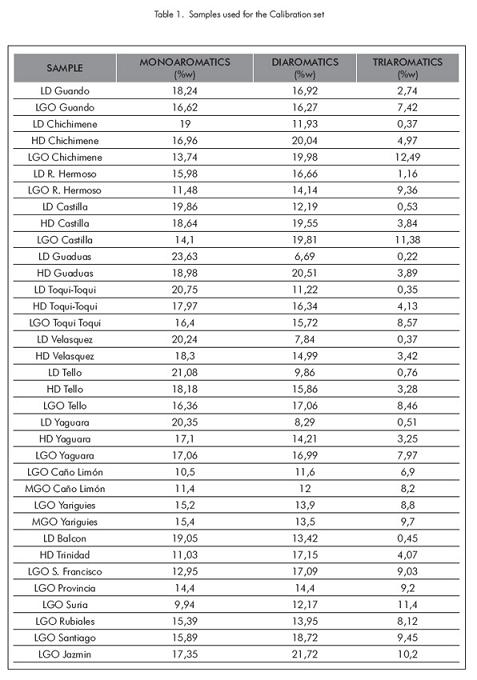
Hydrocarbon type data obtained by this way provided the input for determination of response factors for the aromatic species quantification. The group of samples included fractions such as Light Diesel (LD), Heavy Diesel (HD), Light Gas Oil (LGO), Medium Gas Oil (MGO) and Heavy Gas Oil (HGO).
Chromatographic analysis
The modular WATERS HPLC liquid chromatograph comprises a programmable pump model 600, an auto sampler model 717, a refractive index detector model 2414 and a diode array detector model 996. In order to carry out the separation a normal phase SUPELCOSIL LC-NH2 column was used. Its specifications are: 250 millimeters (mm) of length, 4,6 mm of internal diameter and particle diameters of 5 micrometers (µm). As mobile phase n-heptane was used setting a flow of 1 milliliter per minute (ml/min). Initially the performance of the column for pure compounds was evaluated, then further studied with the samples previously selected. Sample solutions were prepared in n-heptane 1 %( w/w) and 10 microliters (µL) injected to the column for each separation. The temperature of the chromatographic system was maintained at 308,15 K and the total running time was up to 20 minutes, depending on sample complexity. The acquisition and processing of the chromatograms were managed with MILLENIUM® software.
Generation and verification of prediction models
Starting from the hydrocarbon type analysis data determined by high resolution mass spectrometry of the selected samples, prediction models were developed to obtain the aromatic species content based on the HPLC signals. The models were generated with the help of the statistical software STATGRAPHICS PLUS®. The prediction models were validated with a group of samples derived from different crude oils displaying boiling ranges similar to the ones used for generation of the models.
RESULTS AND DISCUSSION
Evaluation of the column compared to pure compounds
Figures 1 and 2 show the chromatograms obtained from the refractive index and the diode array detector during the evaluation of the SUPELCOSIL LC-NH2 column selectivity with different aromatic compounds. The selectivity of the column for non aromatic and aromatic species with one, two or three rings can be observed, which allow differentiating easily such species according to their retention times. It is important to point out that the detection systems used are sequentially coupled and for that reason there are small differences in the signal retention times generated by the same compound on each detector. Additionally, in each detection system the same compound presents different response making it necessary to choose carefully the concentration and the volume of the injected solution in order to avoid detector saturation problems and the loss of response linearity.
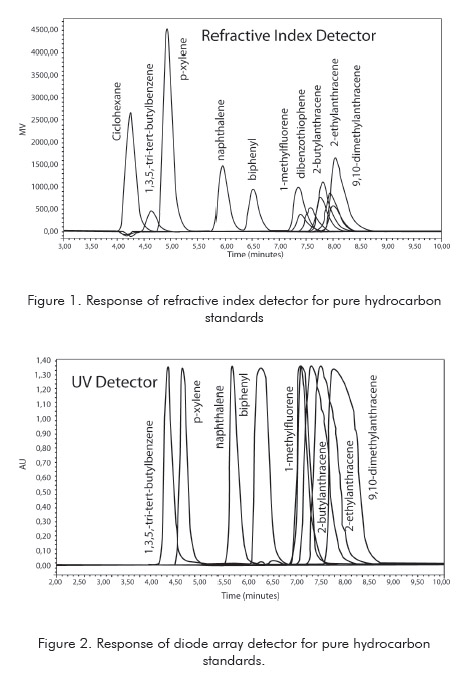
Evaluation of the column for the separation of light fractions
Figures 3 and 4 show the Refractive Index (IR) and UV chromatograms obtained for three different fractions of Castilla crude oil. It can be easily seen how dramatically the resolution power of the column decreases in the separation of the aromatic species as the complexity of the sample increases. The chromatographic profiles of the light and heavy diesel show defined peaks that, according to the retention times of the model compound, can be easily assigned within the RI chromatogram as follows: non aromatic hydrocarbons (~4min) and mono (~4,7min), di (~5,6-5,7min) and tri-aromatic (remaining) species respectively (see assignments in the ensuing discussion). The chromatographic profile of the light gas oil presents wide bands and new absorption regions that indicate an increase in the complexity of the chemical composition of the sample.
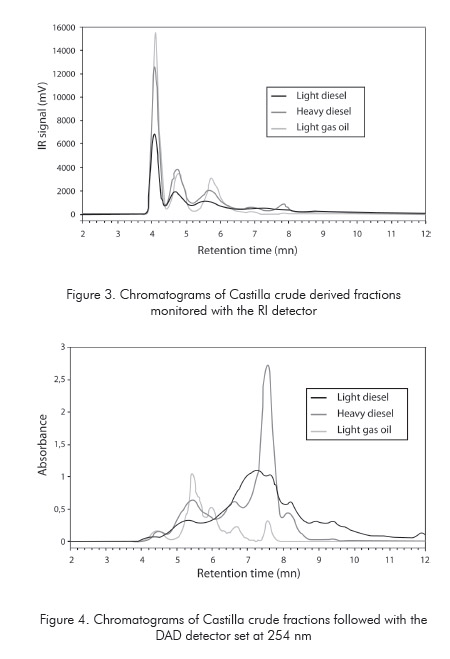
Identification of aromatic species
As formerly discussed, from the results presented within Figure 3 the IR detector clearly displays non aromatic components corresponding to the first high intensity peak, and two bands corresponding to the mono and di aromatic structures respectively. Non aromatic hydrocarbons present an insignificant absorption compared to aromatic hydrocarbons in the UV region (Figure 4). However, aromatic compounds show strong signals in the UV spectral domain. Therefore, it is preferable to use the diode array detector for identification of the aromatic species, thus minimizing the interference that non-aromatic structures may produce (Figure 4). By selecting the detection wavelength of the diode array detector, it is possible to increase the absorbance response for certain species, facilitating in this way their identification. Taking advantage that the aromatic hydrocarbons present adsorption maxima at specific wave lengths depending upon the number of rings and, therefore, of double bonds, it is possible to extract the UV spectrum in the retention time where the maximum absorption of each species is presented, indicating the time-window into which each hydrocarbon family appears. The mono-aromatic species present an absorption maximum in the region of 200 nm to 220nm; likewise, the di-aromatic species in the boundary of 220nm to 240nm and the tri and poli-aromatic species in the region above 240nm. Figure 5 shows the chromatogram for the light gas oil derived from Castilla crude oil measured at three different wave lengths where the maximum aromatic species absorbance is obtained. The mono and di aromatic species are clearly identified from the chromatogram using wave lengths of 207nm and 227nm respectively.
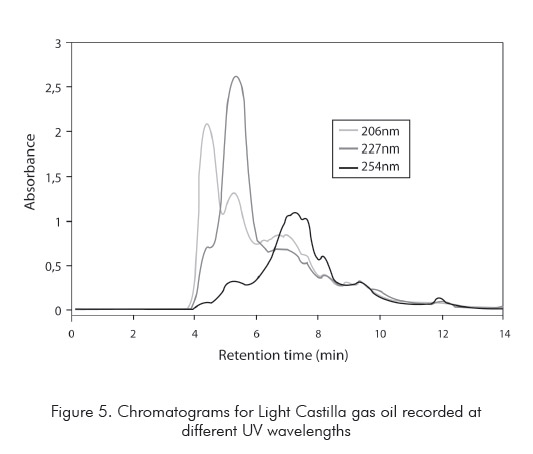
In order to improve a setting for characteristic retention times for aromatic structures, the ultraviolet spectra at different elution times from the chromatographic column were analyzed. Figure 6 shows the ultraviolet spectra extracted in the retention times where the maximum absorbance for each aromatic group is found. A characteristic ultraviolet spectrum for mono aromatics species with their maximum absorbance of 206 nm can be observed. For diaromatics the spectrum presents a maximum at 227 nm and for the tri-aromatics a complex UV spectrum is observed with a differentiated strong absorption maximum in the region of 260 nm. If carefully observed the 254 nm UV chromatogram for the Castilla light gas oil (Figure 5) contains a series of peaks detected after ~10 minutes, corresponding to structures of more than four aromatic rings. The UV spectra for these species were also evaluated and display large differences with those shown on Figure 6, but they were omitted from the figure in order to avoid confusion.
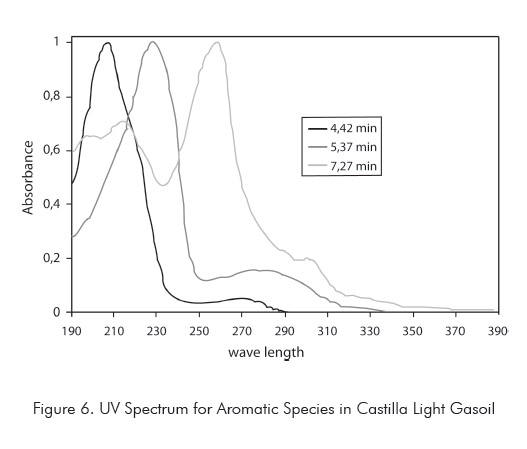
From the former discussed findings, Table 2 shows the assigned retention times for the different aromatic species. It is important to point out that these times apply only for the established experimental conditions set during this study.
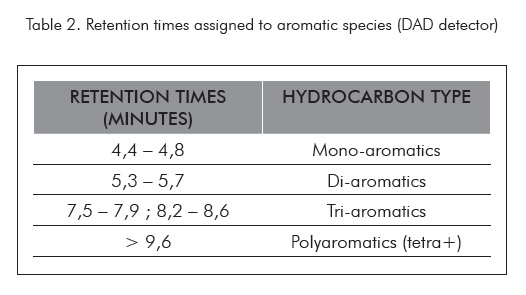
Prediction models matrix calculations and application of the models for predictive purposes.
For mono, di and triaromatic species previously identified (Table 2) a multiple lineal regression analysis was performed in order to derive prediction models for each species as a function of the ultraviolet spectrum extracted in the corresponding retention times. For such regressions a calculation matrix was generated, each line representing the ultraviolet spectrum extracted with the corresponding content of each aromatic species determined by mass spectrometry.
The obtained prediction models for the contents of mono, di and tri aromatics respectively are:
Prediction model for mono-aromatics content:
(0,635711 - 1,70034 AΛ212nm + 3,75411 AΛ222nm + 111,569 AΛ235nm - 264,769 AΛ237nm + 497,618 AΛ240nm - 412,805 AΛ242nm + 138,409 AΛ257nm - 232,827 AΛ266nm + 169,529 AΛ267nm)
Prediction model for di-aromatics content:
(0,523054 - 3,30818 x AΛ213nm + 3,48149 x AΛ222nm - 2,98551 x AΛ228nm - 10,4763 x AΛ235nm + 29,7068 x AΛ237nm - 22,755 x AΛ238nm + 104,006 x AΛ241nm - 194,011 x AΛ242nm + 258,61 x AΛ245nm - 165,311 x AΛ246nm + 2,71046 x AΛ279nm)
Prediction model for tri-aromatics content:
(0,187497 - 17,8019 x AΛ205nm + 22,9477 x AΛ211nm + 46,3587 x AΛ240nm - 39,6187 x AΛ241nm + 92,1245 x AΛ273nm - 153,01 x AΛ274nm + 51,4391 x AΛ277nm - 9,476 x AΛ295nm - 27,1425 x AΛ300nm + 33,3484 x AΛ306nm)
In the previous models variable AΛ corresponds to the measured absorbance at a given wave length. Table 3 shows the statistical parameters of each one of the proposed models.
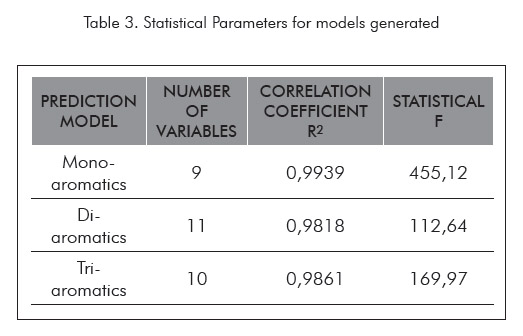
The results obtained for the correlation coefficient and the F test show that the generated models are statistically significant with confidence levels above 95%.
Table 4 compared the results by HPLC and GC-MS method for the calibration set samples.
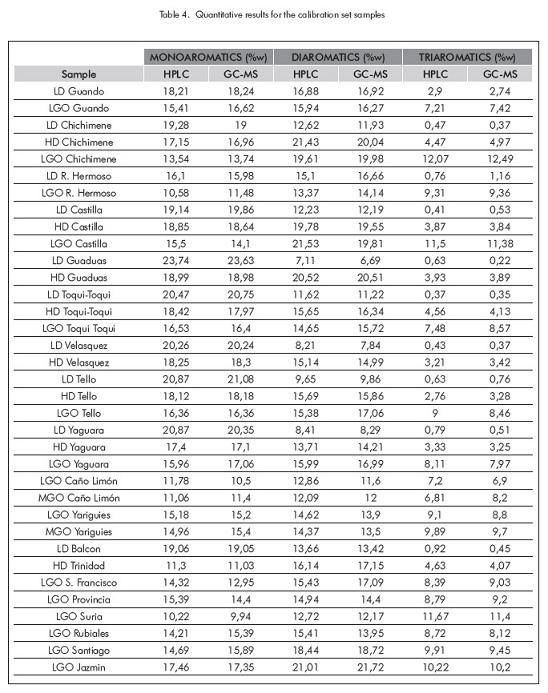
Applicability of the method to light distillates
The previously generated models were evaluated with 14 samples of diesel and compared with reported results by mass spectrometry. Table 5 shows the results obtained for the light Desel Samples (DL) and Heavy Diesel (DP). The results are presented in weight percentage both by Mass Spectrometry (GC-MS) and HPLC either.
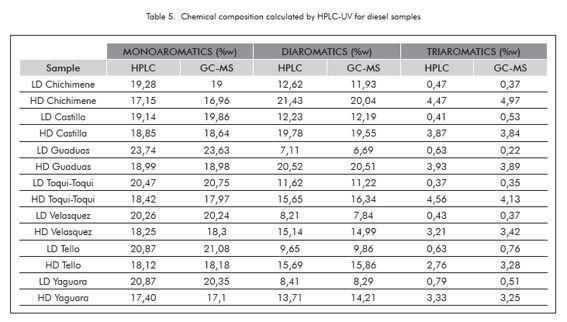
For the mono-aromatic hydrocarbons the average relative error between the calculated chemical composition by HPLC and the reported by mass spectrometry was 1,18%, for the di-aromatic hydrocarbons was 3,30% and for the tri-aromatic hydrocarbons was 15,21%. The error magnitude for triaromatics is due to the low content of this type of hydrocarbon in the samples used for generation of the prediction model, causing that small differences between the experimental values ended-up as large errors. However, from the results presented on the last two columns from Table 5, the agreement seems really reasonable for practical purposes. There is only one result presenting a large deviation (see LD Guaduas).
Applicability of the method to heavy distillates
The proposed method was evaluated with 13 gas oil samples including heavy gas oils that were not included within the group of samples used in the models generation. Table 6 summarizes the results obtained in this evaluation.

The previous data show results according to expected tendencies between light and medium gas oils because normally the fractions become more aromatics with the increasing in its boiling point as could be observed in the calibration set data (Table 1 and 4). For the heavy gas oil samples serious deviations compared to the expected tendency are found. This is due mainly to the loss of resolution in the separation of aromatic species in the chromatographic system. In Figure 7 it is easily seen that separation resolution is impaired with increased complexity of the sample under analysis. It is important to point out that the change of the form of elution bands indicates the presence of new and more complex aromatic species, which causes important changes in retention times and measured absorbance, creating this way major deviations when compared to expected values due to the light nature and lesser complexity of the samples used in the prediction model generation.
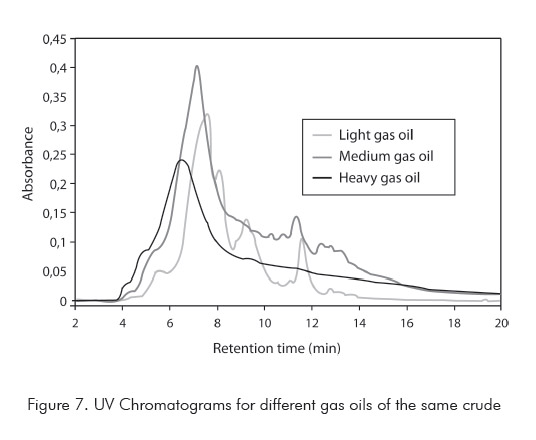
CONCLUSIONS
• This paper presents the development and application of liquid chromatography as an analysis alternative when traditional analysis methods are not available for petroleum derived products. The method compares favorably with labor intensive and materials demanding open column methodologies. The proposed method requires amounts of samples of less than 0,1ml, instrumental analysis times of 20 minutes and mobile phase flow of 1ml/min.
• The algorithm used for the calculation of the aromatic species contents indicates a high correlation with the mass spectrometry reported data. The inputs for prediction models comprise the weight of the initial sample, the volume of the prepared solution and the absorbance values in the range from 190nm to 400nm, wavelengths within which the maximum absorption of each one of the identified aromatic species was found.
• The proposed method shows the expected trends in aromatic hydrocarbons contents when evaluating a group of derived samples from the same crude oil up to the range of medium gas oil. Great deviations from the expected tendencies are found when trying to extrapolate the prediction method to heavy distillates. Heavy samples complexity impairs separation resolution, limiting in this way the application of HPLC characterization to this set of samples.
• It was found that the ultraviolet detector was more suitable for models generation thanks to its greater sensitivity for detection of aromatic compounds, compared to the response obtained with the refraction index detector.
ACKNOWLEGEMENTS
Authors wish to express their sincere acknowledgements to the downstream research unit of Ecopetrol S.A - Instituto Colombiano del Petrsleo (ICP) for financing this study.
REFERENCES
ASTM D 2007. (1998). Standard test method for characteristic groups in rubber extender and processing oils and other petroleum-derived oils by the clay-gel absorption chromatographic method. [ Links ]
ASTM D 4124. (1997). Standard test methods for separation of asphalt into four fractions. [ Links ]
ASTM D 6379. (2004). Standard test method for determination of aromatic hydrocarbon types in aviation fuels and petroleum distillates - High performance liquid chromatography method with refractive index detection. [ Links ]
ASTM D 6591. (2000). Standard test method for determination of aromatic hydrocarbon types in middle distillates - High performance liquid chromatography method with refractive index detection. [ Links ]
Boduszynski, M. M., Hurtubise, R. J., & Allen, T. W. (1983). Liquid chromatography / field ionization mass spectrometry in the analysis of high-boiling and non distillable coal liquids for hydrocarbons. Anal. Chem., 55 (2), 225-231. [ Links ]
Bouquet, M., & Brument, J. (1990). Characterization of heavy hydrocarbon cuts by mass spectrometry routine and quantative measurements. Fuel Sc. Techn., Int., 8 (9), 961-986. [ Links ]
Chaffin, J. M., Lin, M., Liu, W., Davison, R. R., Glover, C. J., & Bullin, J. A. (1996). The use of HPLC to determine the saturate content of heavy petroleum products. J. Liq. Chrom. & Rel. Technol., 19 (10), 1669-1682. [ Links ]
Fisher I. P, & Fisher P. (1974). Analysis of High boiling petroleum streams by High resolution mass spectrometry. Talanta, 21: 867-875. [ Links ]
Fourneron, J. (2001). A chromatospectroscopic method for analyzing the signals generated during high-performance liquid chromatography with diode-array detection. J. Chromatogr. Sci., 39: 160-164. [ Links ]
Gallegos, E. J., Green, J. W., Lindeman, L. P., LeTourneau, R. L., & Teeter, R. M. (1967). Petroleum group-type analysis by high resolution mass spectrometry. Anal. Chem., 39 (14), 1833-1838. [ Links ]
Pasadakis, N., & Varotsis, N. (2000). A novel approach for the quantification of the hydrocarbons groups in heavy petroleum fractions by HPLC-RI analysis. Energy & Fuels, 14 (6), 1184-1187. [ Links ]
Pasadakis, N., & Varotsis, N. (2000). Optimization of the HPLC separation of aromatic groups in petroleum fractions. Fuel, 79 (12), 1455-1459. [ Links ]
Pasadakis, N., Gaganis, V., & Varotsis, N. (2001). Accurate determination of aromatic groups in heavy petroleum fractions using HPLC-UV-DAD. Fuel, 80: 147-153. [ Links ]
Qiang, D., & Lu, W. (1999). Hydrocarbon group-type analysis of high boiling petroleum distillates by HPLC. J. Petrol. Sci. Eng., 22 (1), 31-36. [ Links ]
Rashid, H. A., Fakhri, N. A., Dekran, S. B., & Abdulla, N. I. (1989). Chromatographic separation and characterization of mono-, di- and triaromatic hydrocarbons in gas oil. Fuel Sci. and Technol., 7 (3), 281-291. [ Links ]
Robbins, W. K. (1998). Quantitative measurement of mass and aromaticity distributions for heavy distillates 1. Capabilities of the HPLC-2 system. J. Chromatogr. Sci., 36: 457-466. [ Links ]
Ronningsen, H. P., & Skjevrak. (1990). Characterization of North Sea petroleum fractions: aromatic ring class distribution. Energy and Fuels, 4 (5), 608-626. [ Links ]
Roussis, S. G., & Fitzgerald W. (2001). Hydrocarbon compound type analysis by mass spectrometry: On the replacement of the all-glass heated inlet system with a gas chromatograph. Energy & Fuels, 15 (2), 249-316. [ Links ]
Sarowha, S. L. S., Sharma, B. K. Sharma, C. D., & Bhagat, S. D. (1996). Compositional studies on gas oil fractions using high-performance liquid chromatography. Fuel, 75 (11),1323-1326. [ Links ]
Sarowha, S. L. S., Sharma, B. K. Sharma, C. D., & Bhagat, S. D. (1997). Characterization of petroleum heavy distillates using HPLC and spectroscopic methods. Energy & Fuels, 11 (3), 566-569. [ Links ]
Sink, C. W., & Hardy, D. R. (1994). Quantification of compound classes in complex mixtures and fuels using HPLC with differential refractive index detection. Anal. Chem., 66 (8), 1334-1338. [ Links ]
Varotsis, N., Pasadakis. N., & Gaganis, V. (1998). A novel approach for the characterization of aromatics in petroleum fractions using HPLC-UV-DAD and evolving factor analysis. Fuel, 77 (13), 1495-1502. [ Links ]














